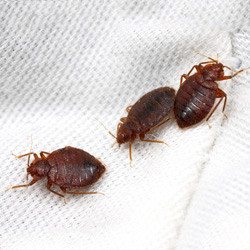 There is no question that bed bug infestations are on the rise and, during the past few years, have steadily increased throughout the United States and the world. This causes increased anxiety for both customers and business owners who are paranoid about exposure to bed bugs. One result from this paranoia is the large number of pests that are mistakenly assumed to be bed bugs.
There is no question that bed bug infestations are on the rise and, during the past few years, have steadily increased throughout the United States and the world. This causes increased anxiety for both customers and business owners who are paranoid about exposure to bed bugs. One result from this paranoia is the large number of pests that are mistakenly assumed to be bed bugs.
For your convenience, we have compiled a list and description of the most common pests found at commercial businesses that are mistaken for bed bugs.
1. Bat Bugs and bed bugs not only have similar sounding names but they are very similar in appearance. The most notable difference between these two bugs is the length of fringe hairs on the portion of the body just below its head. The hairs on a bat bug will be longer than that of bed bugs. Bat bugs are normally found in attics or near bat roosts. They feed on bat blood. However, if their bat hosts leave, these bugs will seek blood nearby and bite humans. As you can see, one could easily mistake the bat bug as a bed bug.
2. A newly hatched cockroach can easily be mistaken as a bed bug. As they molt and grow, cockroaches are much easier to differentiate from bed bugs. Cockroaches, like bed bugs, are active at night and hide in cracks and crevices during the day.
3. Wood ticks, aka dog ticks, are also a flat and oval shaped critter which can make them look similar in appearance to bed bugs. Although their appearances may be similar, wood ticks are quite different because they are usually found outside where bed bugs are found indoors. Also, when ticks feed, they attach themselves to one spot on the body whereas bed bugs feed in many places.
4. Carpet beetles are approximately 3 millimeters long and can cause much damage to fabric, clothing, furniture and carpet. Any type fabric that contains natural animal fiber is a great attractant to the carpet beetle. Although the same shape as bed bugs, bed bugs are flat.
5. The color of spider beetles is similar to the coloring of an adult bed bug. They normally forage for plant-based food materials around in the house. But much like bed bugs, they are nocturnal, foraging at night and hiding in dark locations. They will be seen in cracks and crevices, much like that of a bed bug. However, they are not flat.
Learn More About Bed Bugs & Control
Bed bug adults are broadly oval and flat measuring 3/16 of an inch (4-5 millimeters) long; brown to reddish brown (after feeding). Bed bug eggs and young (smaller, unfed bed bugs) are white or light gray in color. Bed bugs commonly infest hotels, planes and anywhere large crowds gather. Learn More
How much do you know about bed bugs?
See below to take our quiz!
Ask The Pest Control Experts
Ask the Expert. Do you have a specific pest question that you’d like answered? Our technical experts are happy to help!
To further help avoid mistaken identity of bugs, it is important to become familiar with the characteristics of an adult bed bug. The adult is about 4-5 millimeters in length, somewhat like the size of an apple seed. The bed bug will become a mahogany or rusty brown upon reaching maturity. They have 6 legs and a set of underdeveloped, non-functional wings.
These descriptions are to assist you in the proper identification of bugs. Ultimately, the best approach is to contact your local Copesan pest management experts for pest identification and appropriate control measures, if needed, for the critters.
